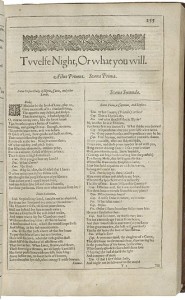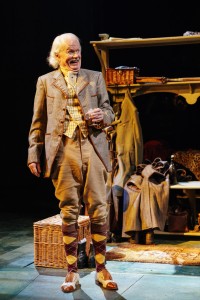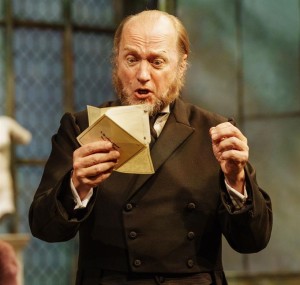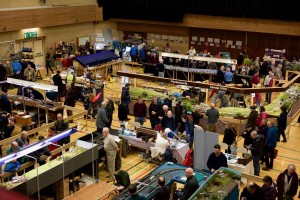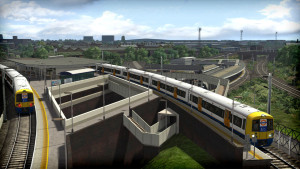Twelfth Night, again
19 February 2018
I’m sure I have read somewhere that Twelfth Night is the most often produced of all Shakespeare’s plays. I don’t know whether this is true – surely As You Like It, and possibly Much Ado (my favourite of all his plays), must run it close. And anyway, who’s counting?
But it is certainly true that Shakespeare’s plays are performed far more often than anyone else’s, not just in Britain but pretty much anywhere in the world that Western culture has taken hold. And this, despite the fact that the language in which he writes has changed, if not beyond recognition then certainly beyond the point of easy comprehension. I go to Shakespeare productions three or four times a year, and my ear should be accustomed to his rhythms and vocabulary, but even so it usually takes ten or so minutes at the start of each production for me to tune in to the language. And I do not think this is just due to some defect in my hearing.
Modern directors often make extensive cuts in the original text, not only to remove or clarify the most obscure passages but also to keep performances to a reasonable length. Sometimes the cuts are made with no other purpose. But they may also be made in order to bring some thought or theme from the play into stronger relief. A couple of years ago John and I saw an RSC production of Julius Caesar by Gregory Doran, set in contemporary Africa with a predominantly black cast, and played over two and a half hours without an interval. Doran made drastic cuts to the second half of the play, throwing all its weight into the first half during which Caesar is assassinated and Antony makes his famous speech. This gave the play an unstoppable momentum like a good thriller, highlighting the dangers of demagoguery and the unpredictability of revolution. The setting made perfect sense and gave the play a vivid contemporary relevance.
One reason why Shakespeare stands at the pinnacle is that his plays are so open to this kind of reinterpretation. Not that it always works. Some years ago John, Georgina and I saw an RSC production of Macbeth, with Patrick Stewart in the title role, which had been brought forward to the twentieth century. In this context the witches, who are of course central to the plot, make no sense at all, and the director’s attempts to paper over the difficulty didn’t help. As a result Stewart’s fine performance (he is one of our favourite actors) was wasted.
Even if the setting is changed, it can help to have some idea of Shakespeare’s original purpose. I wrote last year (blog on 4 April) about the National Theatre’s production of Twelfth Night, directed by Simon Godwin, with Tamsin Greig as Malvolia. What I remember about that production is not the gender change in the role of Malvolio, nor even Greig’s performance (though she was very good), but how Shakespeare’s intentions were suddenly clear. I had always previously been troubled by how he delights in humiliating Malvolio far beyond what his prissy, pompous character deserves. But when you see him as an emblem of Puritanism, which must have been loathed and feared by Shakespeare and his audiences, it makes sense.
John and I have just been to see another production of Twelfth Night, this time by the RSC at Stratford and directed by Christopher Luscombe, with Adrian Edmondson as Malvolio. The play was given a Victorian setting and I was amused to see on stage a large music machine rather similar to those at the Musical Museum near Kew (blog on 24 August last year), though this one had apparently been set up to produce only musical-box type sounds.
I should guess that Luscombe has the same qualms as I did about how Malvolio is treated by the other characters: not just hoodwinked by a forged letter, which on its own is a good practical joke playing on his misplaced ambitions, but confined in a dark cell and taunted. It is impossible to keep the play coherent if the confinement is omitted altogether, but this production makes significant cuts in the text for this production which remove most of the gloating over Malvolio’s plight, and the effect is to dilute the nastiness.
Luscombe has, however, retained the melancholy streak which gives Twelfth Night much of its flavour. Most directors embody this streak in the character of Feste, Olivia’s fool: he sings several songs with wistful words and (usually) melancholy music. Here, however. Luscombe’s composer Nigel Hess gives the songs a much more upbeat quality. Feste appears much more self-indulgent and cruel (it is he who taunts Malvolio in his cell), and he creeps off stage before the end, thus avoiding recriminations. The final song, which should be his, is instead sung by the whole cast, in the RSC’s usual manner – their productions of comedies nearly always end with a bit of a song and dance.
The melancholy part is given instead to Sir Andrew Aguecheek (played by Michael Cochrane), who is usually no more than a comic foil for the vulgar Sir Toby Belch (John Hodgkinson), but here is shown as an old man whose delusions are gradually stripped away. It was Aguecheek who earned the audience’s one groan of sympathy. I really liked this interpretation which gave the figures of Sir Toby and Sir Andrew much more distinct personalities.
I also liked the final scene, immediately before the song and dance, in which the four lovers do not embrace but stand apart from one another as the lights go down. I wonder whether Luscombe intends to suggest that the greatest fun was in the chase, and now they have found one another a kind of reality has dawned. The play’s most touching moment is, as it should be, the recognition scene between Viola and Sebastian, sister and brother. Recognition scenes are a Shakespearean staple and can be predictable or clumsy, but here Luscombe gives them just the right blend of humour and feeling without a taint of irony. Very well done.
John had told me before the show that he might not have wanted to come if he had known it was Adrian Edmondson who would be playing Malvolio. Edmondson is best known for his part in the anarchic, sometimes vulgar, television comedy The Young Ones; not an obvious choice for Malvolio, who may be many things but certainly not vulgar. In fact, though, he gives an excellent performance, not the least bit over the top. Even in the scene where he reads the forged letter and capers around the stage as he imagines a change in his fortunes, Edmondson stayed in character. Indeed he gave Malvolio a hint of pathos; he is deluded, but not simply a figure of fun who deserves only to be mocked. A very different interpretation from Tamsin Greig’s.
As usual at the RSC the cast were uniformly excellent. They spoke Shakespeare’s lines clearly and naturally. I was a little worried when Dinita Gohil, as Viola, delivered her opening line “What country, friends, is this?” upstage and direct to the audience, in a declamatory style that went out of fashion a hundred years ago. But it must have been deliberate (though I can’t imagine why), because after that she reverted to the RSC’s usual, natural style. I am not sure she is ideally cast: it is even more difficult than usual to believe that Olivia cannot see that “Cesario” is in fact a woman in disguise. Perhaps I am too literal-minded.
Notwithstanding the elements of melancholy and pathos, Twelfth Night is a comedy, and this production makes the most of it: not just in the obvious set-pieces like the letter scene and the duel contrived by Sir Toby Belch between Aguecheek and Cesario, which neither of them wishes to fight, but throughout. We certainly enjoyed it; there were plenty of laughs. The play may be familiar, but it can still be made fresh, and Luscombe, with a few deft twists and a talented cast, has done so.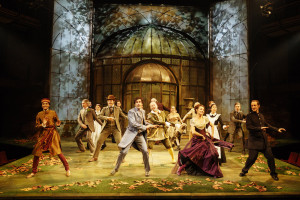 ——————–
——————–
Model railway exhibition
7 February 2018
John and I spent his birthday weekend up in Cark. We were unlucky with the weather, but that gave us the opportunity to pay a couple of visits to Kendal. On Saturday we went to Currys to buy a new laptop computer for John’s birthday present and a new television for Stable Mews. On Sunday we went to a model railway exhibition: the first time I had been to such an event for about ten years.
As children we used to go regularly with Dad to these exhibitions whenever they were held locally. I still have a memory of one (possibly in Manchester) at which there was a model tram system on display. These were the old-fashioned double-decker trams which were the precursor of buses in many British cities. They were beautifully modelled, evidently from scratch as there were no proprietary models or model kits of trams available at the time. (I would certainly have known!) They even seemed to be receiving their power from the overhead wires which had likewise been constructed from scratch. At the time I would still have had clear memories of the trams that operated in Liverpool until 1957, when I was four years old. If I could revisit one single model railway from my boyhood, this would be it.
Of course we had our own model railway too. It had two incarnations. The first was on a baseboard, 6’ x 4’, with an oval of track and several sidings. Later Dad added a second oval, built on a kind of wooden viaduct above the baseboard. We always called this the overhead, echoing the famous Liverpool Overhead railway which closed in 1956. With the addition of the overhead, we could have two trains running at the same time. I still have quite a clear memory of the complete layout and the trains which we ran on it.
After we moved house in 1962, Dad installed a folding ladder into the loft space (that’s the attic, for you Australians), fitted wooden floorboards across the joists, and constructed single-deck shelving at about waist height around the loft, making a complete circle. This formed the baseboard for the model railway to be rebuilt, with a principal station (we owned a Hornby kit for this) and two complete loops of track. Over time he rebuilt the overhead too, so that eventually we had three complete loops. Visiting children used to look forward to playing with our trains.
I think Dad had in mind that after he retired he would spend a lot more time with the railway, but it never really worked out like that. Perhaps he found it was just less fun without his sons to join him. And eventually he became unable to manage the steep loft ladder. The trains were put away to protect them from dust, but the tracks lay untended until John and I were ready to sell the house in 2011. John dismantled the entire layout, salvaged as much as he could, and is now trying to piece something together in his own loft space. At ankle height. I don’t know how that is working out for him, but I suspect that it is proving quite a challenge.
Dad used to enjoy just watching the trains go round and round, and made no attempt at all to give the layout a realistic look by adding any kind of background scenery. I was not much bothered about scenery either, but was not satisfied just to run the trains. I wanted them to go from somewhere to somewhere else, just like the real thing; preferably in accordance with a timetable. For three or four years my friend Ian Price and I used to go into the loft and operate an imaginary train service, designating the main station as a real life railway junction and other parts of the layout as destinations. I would work out the schedule and operate the signals; Ian ran the trains.
Ian’s family were good friends of ours. His father, Ted, was a very skilful handyman; John still owns a coffee-table which Ted built for Mum and Dad, I think as a wedding present. It is a beautiful piece of work. Ted and Ian had their own model railway, though not as extensive as ours eventually became, and they subscribed to Railway Modeller magazine, which Ian then lent to me. The magazine used to feature a Layout of the Month (in fact I think it still does), usually with a layout plan. I was fascinated by these featured layouts which were usually far more ambitious than ours, in various ways: more scratch modelling (we used only proprietary model trains, mostly from the two principal manufacturers at the time, Hornby and Triang); more scenery; above all, more attention to operational realism, with double track running, signals controlled from a switchboard and scrupulously obeyed, and a working timetable.
In particular I remember one layout which modelled the line out of London Victoria, through Clapham Junction to East Croydon and destinations beyond. The trains ran into a loop and marshalling yard hidden in a convenient tunnel (modellers call this arrangement a fiddle yard), so “beyond” could be anywhere you cared to name. The article described how the operators aimed to model a full day’s operation of the line, with a clock running at four times normal speed: the challenge was to keep to timetable. I would have loved to do the same, but our circular layout was not set up to run in this way.
The Layouts of the Month seemed to alternate, roughly, between large layouts of this type, with complex trackwork, multiple stations and authentic operation, and much smaller models, often focusing on a single location such as a branch line terminus, in which everything was built from scratch with as much realism as possible. I never found these very interesting, but there is clearly a branch of the hobby which favours detailed modelling above operation. From his blogs you can see that David is a member of this branch.
It seems, from what we saw at Kendal, that the hobby has definitely swung in that direction. I do not think there was a single layout, out of about a dozen on display, which featured more than one station. On the other hand you could see that immense care had been lavished on detailed modelling, not just of the trains but of the track and all the ancillary structures like coal towers, not to mention the background scenery. Our loft railway would be deeply unfashionable today.
 Perhaps the enthusiasts for realistic operations have moved on from model trains to computer simulations. Also on display at Kendal were a couple of PCs running Train Simulator, a computer game which does, indeed, simulate the experience of driving a real train along a real railway. You are offered a first-person view through the front cab window and can see the tracks ahead, complete with signals, stations, junctions and trains passing in the opposite direction. You can call up a control panel to operate the train; the challenge is to keep to schedule without exceeding speed restrictions or (horrors!) passing a signal a danger. You can look to left or right and see a realistic image of countryside or townscape, or change your viewpoint completely to see a third-person view of your train from front or back, left or right or above, though in this case you lose control of the train.
Perhaps the enthusiasts for realistic operations have moved on from model trains to computer simulations. Also on display at Kendal were a couple of PCs running Train Simulator, a computer game which does, indeed, simulate the experience of driving a real train along a real railway. You are offered a first-person view through the front cab window and can see the tracks ahead, complete with signals, stations, junctions and trains passing in the opposite direction. You can call up a control panel to operate the train; the challenge is to keep to schedule without exceeding speed restrictions or (horrors!) passing a signal a danger. You can look to left or right and see a realistic image of countryside or townscape, or change your viewpoint completely to see a third-person view of your train from front or back, left or right or above, though in this case you lose control of the train.
The display we saw was of an electric locomotive pulling a freight train from Stafford to Nuneaton. I know that route quite well and can confirm that the simulation was remarkably accurate. At one point we pulled up at a red signal while two Euston to Manchester expresses (one in each direction) crossed in front of us at Colwich Junction. However, hundreds of different routes in the UK, USA and Europe have been modelled, each with appropriate trains for you to drive.
If you are still interested in what Train Simulator looks like, try this Youtube link: http://bit.ly/2FXedY1. The commentator is a bit pleased with himself, but don’t turn him off, or you will miss the sound cues that are part of the simulation. The basic game is only about £20, but you have to pay a supplement for each new route you add to your game, which could get expensive. And unfortunately it seems to require quite a high-end graphics processor, so I don’t think John will be able to run it on his new laptop. Perhaps I should load it on my big PC at home, in time for his next visit.

